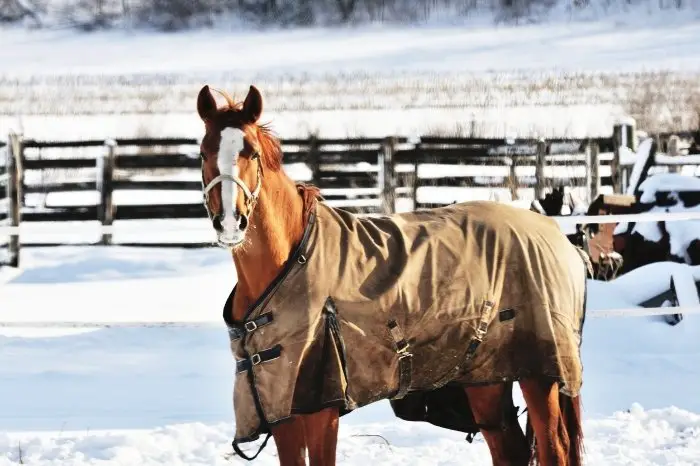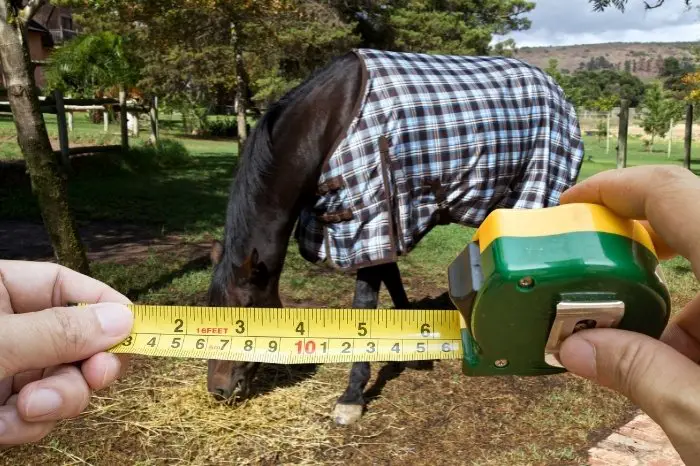Last Updated on February 21, 2023
Buying a new blanket for your horse can be a tricky business, with so many types and sizes of blankets available. Let’s find out how to measure for a horse blanket, and how to choose the right one for your horse!
Why Do Horses Need Blankets?
Most horses owners have a range of different blankets for horses, but have you ever wondered why horses need blankets? After all, a horse in the wild wouldn’t wear a blanket!
There are several reasons why domesticated horses need to wear blankets. The first of these is that we tend to keep breeds of horses in environments, they are not accustomed to. A good example of this is the Arabian horse, which is adapted to live in hot desert conditions but is now kept around the world.

Another reason why horses need blankets is because we often clip their hair off in the winter. This is for practical reasons, as the thick winter coat means the horse will get very sweaty when exercised. However, when the horse is at rest we need to use a blanket to compensate for the hair loss.
And finally, another practical reason why horses need blankets – it keeps them clean and dry! This makes our lives much easier in the winter months, as we don’t need to wait for the coat to dry or brush off lots of mud before going for a ride.
Read more about How To Put An English Bridle Together?
How Do You Measure For A Horse Blanket?
A horse blanket is measured by taking the length of the blanket, running from the front to the back of the horse. A tape measure is held with one end at the center of the horse’s chest, and the other end level with the tail. This distance is the size of blanket that your horse needs.
There can be some slight variation in this measurement, as it depends if you want the blanket to end at the top of the tail, or extend slightly further to form a tent over the tail.
To measure a blanket, you take the same measurement. The blanket is laid out on the ground, and a tape measure used to calculate the distance from the front edge – where the chest buckles are – to the back edge.
If you are not 100% sure what size blanket your horse needs, it is a good idea to borrow a similar-sized one to try on your horse. This will confirm if your measurement is correct, or if you need to go up or down a size.
Click Here to Learn What Is Equine Motor Neuron Disease?
What Types Of Blankets Do Horses Need?
You might be wondering if your horse needs just one blanket, or if he needs a whole wardrobe? Again, it depends on the type of horse and the environment he is living in.
There are two basic types of blankets – stable rugs, for inside the barn or stable, and turnout rugs for horses that live outside. A turnout rug will have a tough outer layer which is waterproof and designed to withstand wear and tear. Stable blankets are softer and more comfortable – think of them like horse pajamas!
Each type of blanket also comes in different thicknesses. A very thin blanket, with no additional padding, is sometimes called a sheet. Thicker blankets can be light-weight, medium-weight, and heavy-weight, to suit different weather conditions.
HILASON 1200D Winter Waterproof Poly Horse Blanket Belly Wrap Red-75 Inches
Some blankets are even adjustable, with inner liners that can be removed when the weather warms up. Alternatively, more than one blanket can be used to create a thicker rug for your horse. Some people like to use a thin stable blanket under a turnout rug to keep the horse warm.
Other less common types of blankets include ones to cool the horse down, such as sweat rugs and coolers, and fly sheets to keep flying insects at bay.
Check Out What Is A Horse Skull X Ray? Equine Head Radiography Explained!
What Happens If Your Horse Has The Wrong Size Blanket?
If your horse has the wrong size blanket, it can cause problems for your horse. It may slip and start to rub the hair, causing bald patches on the skin. The hair may take a long time to grow back, especially if the blanket is not changed for a correctly fitting one.
A badly fitting blanket could also become dislodged, slipping over to one side of the horse. This can be very dangerous, as the horse could get his legs tangled in the straps of the blanket.

Summary – How To Measure For A Horse Blanket
So, as we have learned, the best way to measure for a horse blanket is by measuring the distance from the horse’s chest to the tail. It is important to get the correct size blanket for your horse to prevent the blanket from slipping or rubbing your horse’s coat. Your horse may need more than one blanket, to suit different weather conditions.
We’d love to hear your thoughts on how to measure for a horse blanket! Do you struggle to get the right size blanket for your horse? Or perhaps you’ve got a question about how to choose a blanket for your horse? Leave a comment below and we’ll get back to you!
FAQ’s

Kate Chalmers is a qualified veterinary nurse who has specialized in horse care for the vast majority of her career. She has been around horses since she was a child, starting out riding ponies and helping out at the local stables before going on to college to study Horse Care & Management. She has backed and trained many horses during her lifetime and competed in various equestrian sports at different levels.
After Kate qualified as a veterinary nurse, she provided nursing care to the patients of a large equine veterinary hospital for many years. She then went on to teach horse care and veterinary nursing at one of the top colleges in the country. This has led to an in-depth knowledge of the care needs of horses and their various medical ailments, as well as a life-long passion for educating horse owners on how to provide the best possible care for their four-legged friends.
Kate Chalmers BSc (Hons) CVN, Dip AVN (Equine) Dip HE CVN EVN VN A1 PGCE

